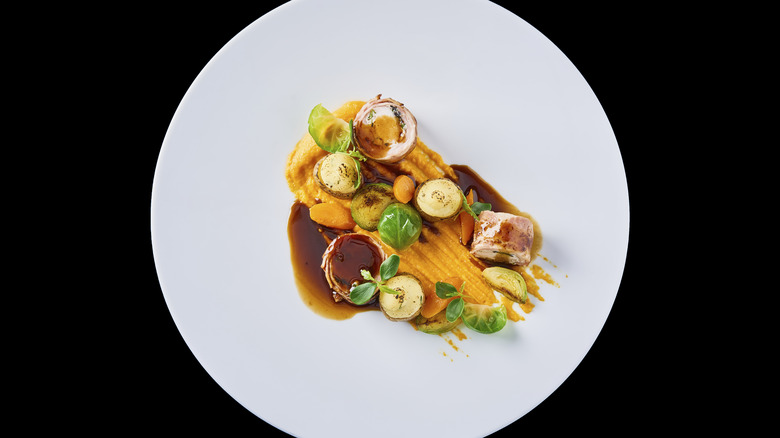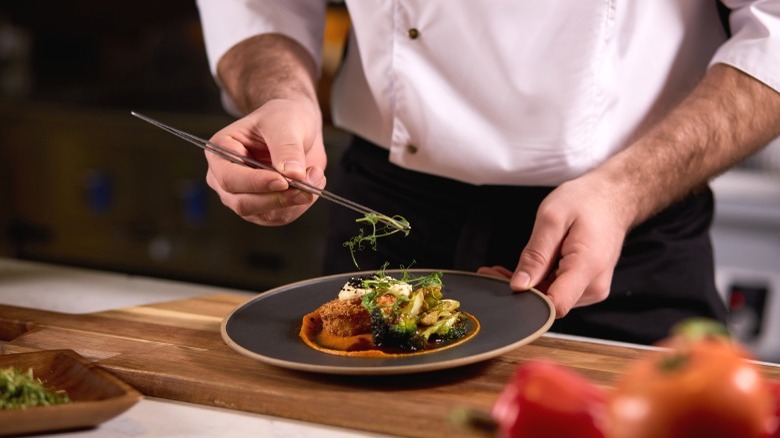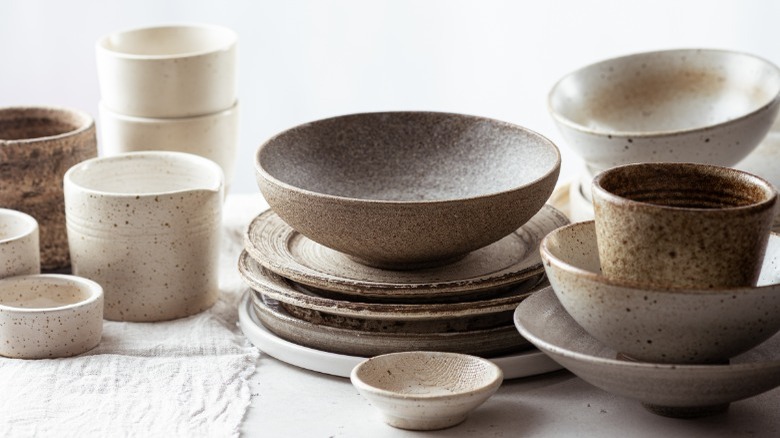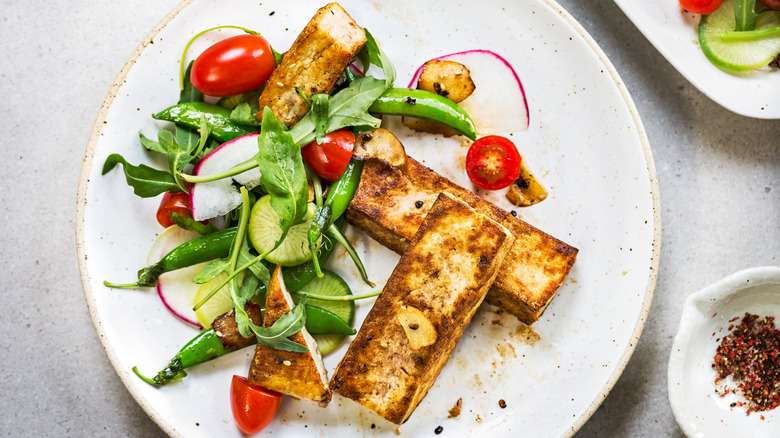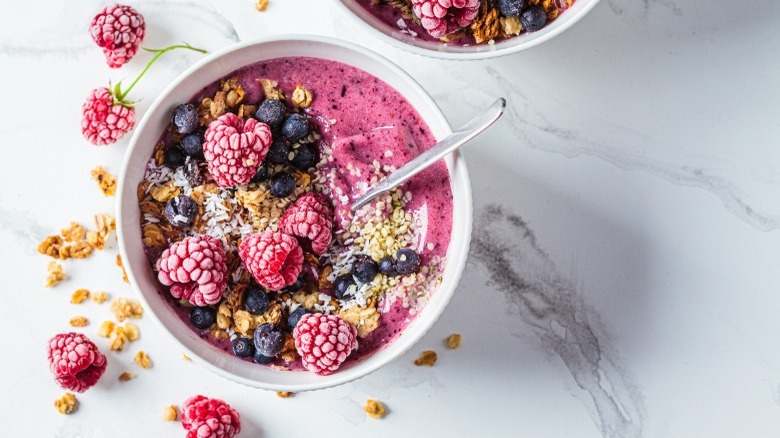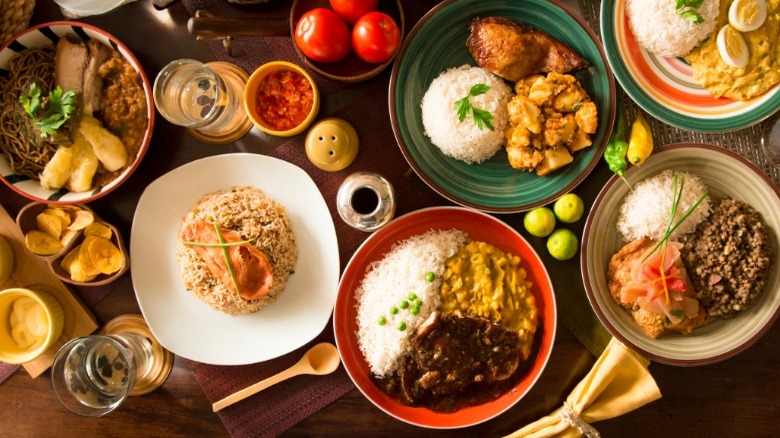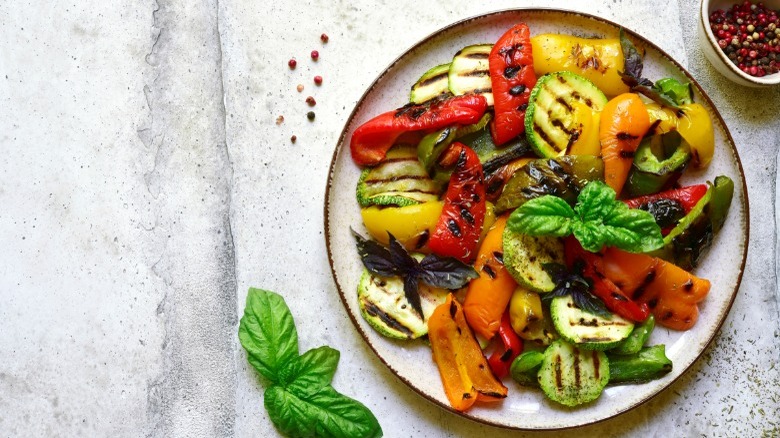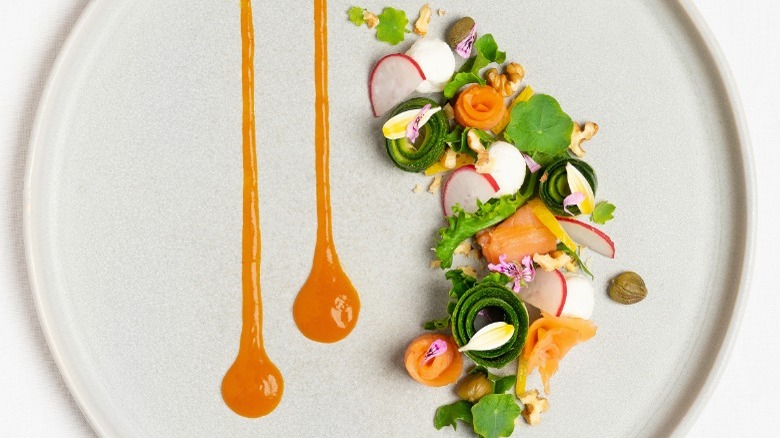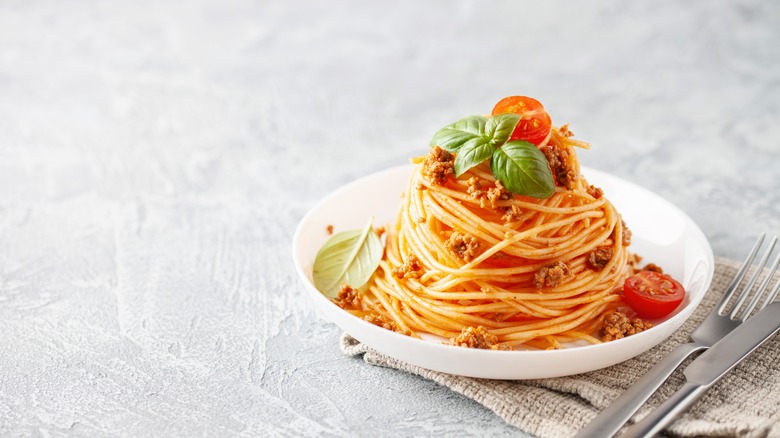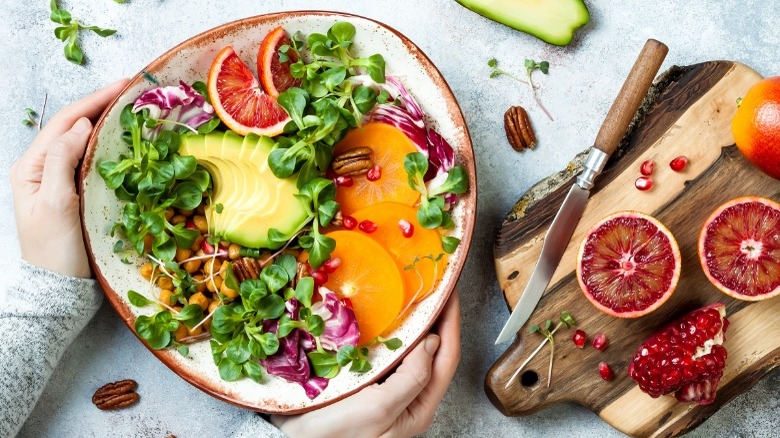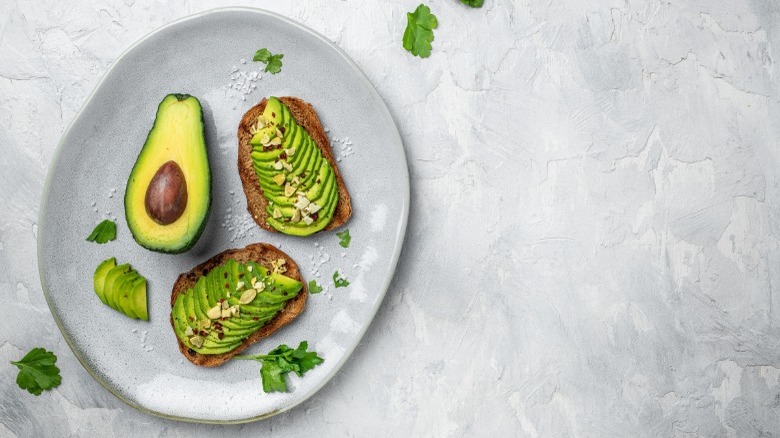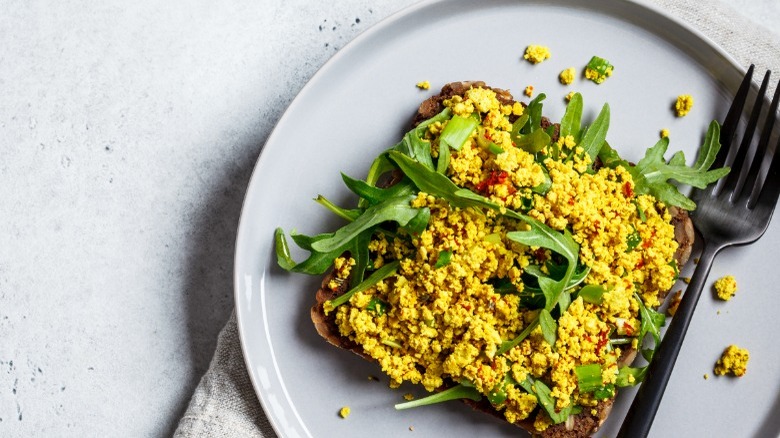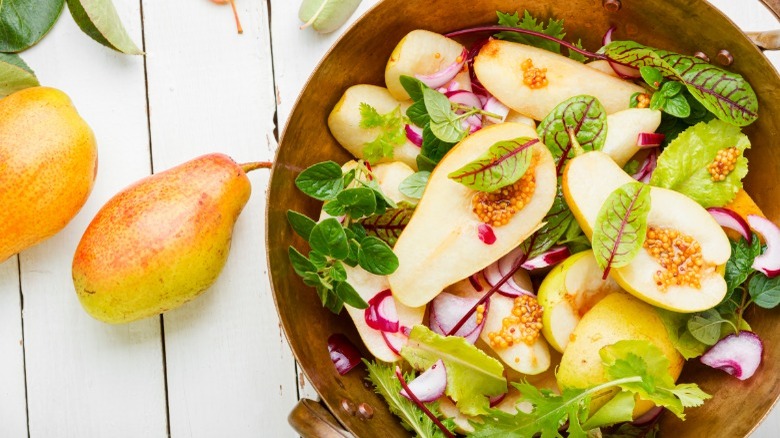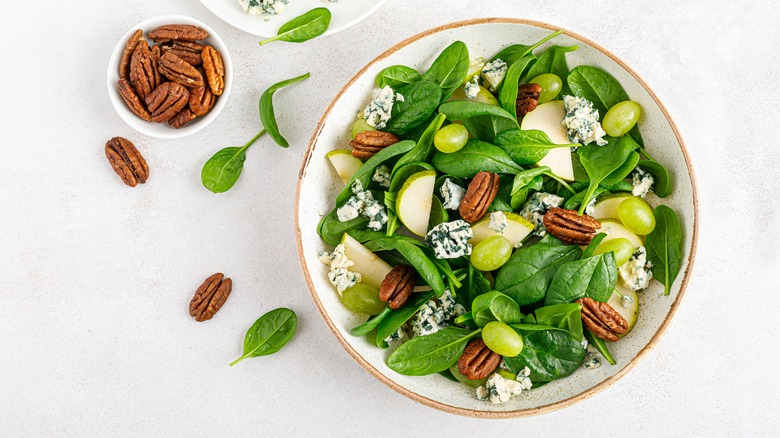13 Plating Tricks To Add Personality To Your Meals
The art of food plating is more important than you think. A skilled, mindful presentation is so powerful, in fact, that it can positively affect our perception of flavor. Whether you're a home cook looking to impress your dinner guests or an aspiring food photographer looking to capture the perfect shot, knowing how to plate your food can take your meals to the next level. It's no secret that professional chefs have an arsenal of plating tricks that can turn a simple dish into a thing of beauty, capable of setting the tone of the whole meal. Fortunately, you don't have to be one of them to create beautiful and Instagram-worthy plates.
With the right approach, you can add flair to your meals, making them not only delicious but visually appealing, as well. So, get ready to explore the secrets of professional chefs and master the plating techniques that will help you elevate your presentation. From employing color theory and optical illusions to your benefit to using the right tools to create patterns, height, and visual accents with precision, there are tips for everyone looking to add more personality to their everyday meals.
Prep your workspace
If you want to plate like a chef, you have to organize your workspace like a chef. What that means in practice is that you have to mentally divide your kitchen into stations, such as prep, cooking, and plating areas. Once you have identified the space for plating, ensure all the food elements are handy.
The next step is investing in a few simple tools that will majorly upgrade your presentation skills. Some of them you might already have on hand — like a regular metal spoon you can use to manipulate sauces and purees on the plate or a kitchen towel that can help you clean off any unwanted splatters. Some, like a squeeze bottle or an offset spatula, can help you create visual accents on the plate with more precision. Don't be afraid to experiment by using tools you already have in unconventional ways: For example, if you want to plate your pasta like a pro, a meat fork should help. Finally, if you wish to plate in the style of a fancy restaurant, you need two more tools. One is a set of metal ring molds, which Anthony Bourdain called the backbone of pretentious food presentation, and the other is a pair of culinary tweezers that will allow you to better control the placement of delicate elements.
Pick the right tableware size and color
Any food professional worth their salt will tell you that in order to plate like a pro, you'll need to pay attention to the dishes you're using. First of all, consider the size of the plate. Some chefs, including Jet Tila, believe that a smaller plate with an indent in the center can help you pack the food more tightly, building it up instead of spreading it around to create a more polished look. This is where the Delboeuf illusion comes into play: An equally sized portion of food will look bigger or smaller, depending on the size of the plate and how much negative space surrounds it.
Pairing the right plate color with the food you're serving is just as important. You don't want the plate itself to look too busy or, on the contrary, visually merge with the food. What you do want is a sense of contrast: red foods on a white plate, yellow foods on a blue one, and so on. You can still add a visually interesting layer by stacking your neutral serving plate on top of a charger plate of a contrasting color. Finally, when in doubt, go for the round white plate, as it is the universal canvas that contrasts and frames most foods well.
Find your focal point
One of the principal rules of plating states that the main element of the dish should be the center of attention. It's the thing that your eyes should naturally be drawn to when presented with a plate. For entrées, the focal point is usually the protein and the rest is a visual and gustatory support cast. So, whatever it is you're serving, determine your grosse pièce (French for "big piece"), or the item that will take the most space on the plate and become the center of attention.
But does the focal point necessarily have to be in the center of the plate? That depends on the mood you're trying to create with your presentation. Centering the main item can convey a sense of symmetry and formality while placing it off-center can help the dish look more relaxed and artistic. You can experiment with the rule of thirds, which is just as helpful in plating as it is in Instagram food photography. Mentally divide the plate into three equal parts vertically and horizontally and place the main ingredient at one of the intersections. In the end, no matter where you choose to put it, the focal point should remain the most prominent element on the plate.
Mix and match textures
Mouthfeel, as well as our expectations of it based on visual cues, plays an essential role in our perception of flavor. Celebrity chefs are well aware of this: For example, Padma Lakshmi adds texture to sautéed zucchini with a generous sprinkle of pomegranate seeds. Their firm, juicy texture and bright flavor contrast the soft consistency and mild flavor of the cooked vegetables, in addition to adding a vibrant visual note to the dish. But the good news is that you don't have to be an experienced chef to create satisfying textural combinations.
One simple yet powerful way to create more depth in a dish is to add a crunchy topping. Be it some seasoned breadcrumbs on top of creamy pasta, fried leek greens in a soup, or toasted nuts over a smoothie bowl, an element that can act as "sonic seasoning" while we're eating has been proven to enhance our perception of the dish. Next, we have smooth, silky elements, such as puréed vegetables and legumes or thick creamy sauces, which can act as a neutral binding base. Finally, some chewy ingredients, such as roasted veggies, fresh bread, or sun-dried tomatoes, will round up the basic triad of textures.
Start with the clock-face technique, and take it from there
This classic technique is a good place to start if you're new to mindful plating. It involves arranging the food on the plate in a clock-face pattern. This method works best for meals with three elements, such as protein, starch, and vegetables. To use it, imagine the center of the plate as the center of a clock and divide it into three parts, with the main ingredient or focal point placed at the bottom half of the plate, between three and nine o'clock, and other components equally dividing the top half. You could experiment by placing the focal point between 12 and six o'clock and dispersing the rest on the opposite side for a balanced and visually appealing presentation.
Once you get the hang of it, go ahead and explore other modern plating methods that range from minimalistic to truly artistic. A clean, modernist look can be found among Nordic restaurants and bloggers. For culinary architects, there are scaling and stacking methods, which create layers and height. A landscaping approach to plating can create both elegant and rustic scenes. Finally, no other plating style can compare with Kaiseki, a Japanese dining experience akin to an art form, with its plates designed to evoke a sense of harmony, both for your eyes and your tastebuds.
Pay attention to the color scheme
There is no denying that the overall color palette can make or break a dish. While the taste of the food remains the same, science says the color impacts your perception of it. Of course, the shades of plates and cutlery are important, as they create context, but so are the dish's own hues. So when designing your dish's color scheme, borrow techniques used by designers, food photographers, and stylists. Most of them rely on the principles of color theory.
Using complementary colors, which would be at the opposite ends of the color wheel, such as red and green, can create a striking visual effect that enhances the contrast. For example, garnish a dish with a bright red sauce with green herbs for a bold presentation. In comparison, plating food in a monochromatic color scheme that uses various shades of the same color can create a sense of harmony and balance. You can achieve this by plating creamy pasta or mashed potatoes with vegan gravy on a beige ceramic plate. If you want to spice it up a little, pairing analogous colors (neighbors on the color wheel) will create a more exciting yet relaxed feel: Think lentil curry served with a side of greens and tomatoes.
Play around with sauces
To swoosh or not to swoosh? That's the question professional chefs have been facing for some time. Inspired by Nouvelle cuisine, a transformative French culinary movement of the 20th century that emphasized presentation, chefs around the world have been tirelessly reaching for their squeeze bottles. Why? To add sophisticated visual elements to the plate, of course. Today, it is slowly going out of fashion, with some celebrity chefs like Rock Harper firmly against the comeback of this plating trend. However, if you've never tried to create accents and patterns with sauces, oils, and purées, follow the likes of Anthony Bourdain, who loved squeeze bottles, and try it.
The appeal of squeeze bottles is that you can conveniently store your condiments and place them on the plate with precision. It works best for uniform, glossy sauces like teriyaki or caramel, perfect for creating patterns. Likewise, a few droplets of herb oil from a squeeze bottle can give your plate a restaurant-worthy look. No squeeze bottle? No problem: Placing a dollop of vegetable purée or hummus on the plate and swooping it with the back of a spoon can create an indent perfect for placing other ingredients over. Finally, consider pooling rich sauces under some vibrant veggies instead of serving on the side or over the food.
Use a stacking approach
Considering we typically see our food not as an Instagram flat-lay but as a three-dimensional item, thinking vertically instead of horizontally when plating your food won't hurt. That doesn't mean you need to build a Jenga tower on your plate, but adopting some stacking techniques can definitely improve your presentation.
That's where the stacking approach comes in: By layering the components of a dish on top of one another, you give it a more dynamic, captivating feel. Just think about how much more appetizing a little mountain of spaghetti looks compared to when it's scattered around flatly. Some dishes, like 100-layer root vegetable gratin or fried potato stacks, can naturally create a sense of elevation. Others, like salads, can be shaped into a little tower using a ring mold. Additionally, flat ingredients, like cucumber ribbons, can be rolled and stacked vertically.
Of course, horizontal stacking is also possible: You can always arrange slices of vegetables or protein with a slight overlap in a row instead of a column. An advanced version of this is scaling, which involves placing foods cut in similar shapes over each other to imitate a fish scale pattern. As long as you consider the balance and proportion of the dish, applying this technique should lead to visually harmonious results.
Establish patterns
From using the golden ratio and the rule of thirds to mixing and matching angular and soft lines, you can improve the flow of the plate with various patterns. Depending on the mood you're trying to convey, they can be strictly geometrical or more relaxed.
One modern technique that is nevertheless easy to execute is plating foods on a curve, often seen at fancy restaurants. Foods arranged in swooshes and arcs create a sense of fluidity and help our eyes travel across the plate, noticing all its elements — similar to how the golden ratio works. Additionally, this technique works best on round plates, which likely comprise most of your tableware repertoire. Repeating straight vertical and horizontal lines can create eye-pleasing, logical patterns and add dimension to a dish. Play around with sauce placement and asymmetrical garnishes to avoid monotony with this approach. Finally, the rule of thirds can be applied by placing the dish's main component at one of the intersection points, then arranging the other parts around it. Whichever method you choose, remember that these patterns are simply guidelines and that creativity and personal style should also play a role in the plating process.
Odd numbers are your friends
Using an uneven number of elements on the plate, also known as the rule of odds, creates a more interesting presentation. This works especially well with fancy appetizers and other individual foods. The human brain tends to perceive odd numbers as more pleasing and interesting than even numbers, which can feel static or monotonous. Keeping this in mind when plating food can help to create a captivating composition and make the dish look more dynamic.
The way you apply this rule can vary. For example, you can arrange three components on a plate, such as starch, protein, and greens. Alternatively, you can mix three or five different colors (don't forget to apply the color theory here, though). Another way to use this principle is to arrange components in a way that would create an odd number of points and angles, such as a triangle or a star. However, it's important to use odd numbers in moderation and not to overcrowd the plate, as this can create a cluttered and unappetizing appearance. Instead, you could mentally divide the plate into three parts and leave ⅓ or ⅔ empty.
Leave negative space
While it's exciting to try new plating techniques when you're starting out, don't let that excitement carry you away completely. A serving of food that's overly busy with garnishes, toppings, and sauces can actually negatively affect our perception of it. So unless you're creating a vibrant Buddha bowl, don't overcrowd the plate; some space at the edges of it will help create a more elegant look.
The rule of thumb is to maintain a buffer zone of about ½ inch between the food and the edge of the plate. You can achieve it easily by using larger plates that will draw your focus to the food and its colors. This isn't always necessary, but if you want to learn how to plate and present food for special occasions, such as a dinner party, intentionally using negative space can breathe some air into your meal and elicit a more gourmet feel. Just make sure those edges are clean — keep a kitchen towel handy for wiping off any accidental splatters.
Experiment with garnishes
Garnishes are like the makeup of a dish — whether it's edible flowers, chives, micro greens, sesame seeds, or powdered sugar, these finishing touches will give your plate a more polished look. They can add flavor, texture, and color and help tie everything together. When it comes to the choice of garnish, take Kristen Kish's advice: Pick ingredients that are not only visually appealing but match the theme and flavors of the dish.
As a home cook, you can use restaurant techniques in your own kitchen by investing in a garnishing kit that includes plating tools like tongs, brushes, and squeeze bottles. However, to make your dishes look like they were prepared by a professional chef, don't overdo the extra elements — you want harmony, not cacophony. Moreover, garnishes should be functional and not merely a decoration: If you add a lemon wedge, it must make sense for the eater to squeeze it over their food. In the end, the art of garnishing encompasses most of the principles discussed in this article: Playing with colors and textures, creating patterns, height, and visual accents, and going for asymmetrical, lively placement in odd numbers.
Get creative, and don't chase perfection
While it's important to know the basics of food plating, the rules are not set in stone. Only through mixing, matching, and adapting the tips and techniques you learn from chefs, bloggers, and other culinary resources can you develop a style of plating that's true to you and the food you like to make. If anything, a rustic-looking arrangement with imprecisely cut vegetables (also known as paysanne) served in a handmade ceramic bowl can evoke more warmth and emotion than a meticulously organized, perfectly executed dish on a plain white plate.
Ultimately, unless you're a food stylist prepping for a photoshoot, you don't want to spend too much time plating, especially hot dishes. So don't sweat it, and don't try to make it perfect. Instead, use your plate as a canvas, apply the techniques you already know gradually, keep it simple when in doubt, and don't be afraid to make it your own. With time, your plating skills will become intuitive and become a reflection of your own unique cooking style.
Static Media owns and operates Tasting Table and Mashed.
